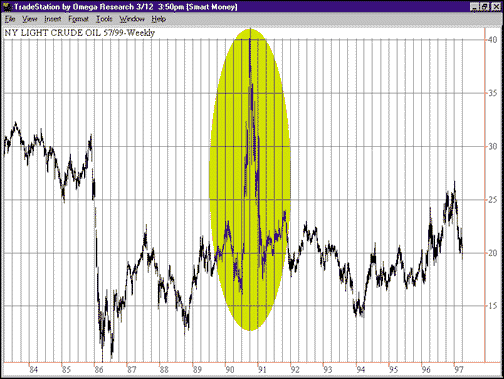TRADING PSYCHOLOGY
Smart Money
by Scott Brown
Should you develop a personal trading system, one that reflects your own personality?

MARKET VOLATILITYFIGURE 1: CRUDE OIL, 1990. Trading the markets is a social phenomenon. Investors are also greatly influenced by mass psychology. This could explain trendlines of markets in the limelight that have dramatic shifts in slope. An example is the petroleum futures bubble at the end of 1990 that was sparked by the Gulf War.
Trading the markets is a social phenomenon. Investors are also greatly influenced by mass psychology. This could explain trendlines of markets in the limelight that have dramatic shifts in slope. An excellent example is the petroleum futures bubble at the end of 1990 that was sparked by the Gulf War (Figure 1). It could also explain stocks in low-volatility channels despite favorable earnings, growth and dividends at the end of bear markets when public interest is low.
EFFICIENT MARKET HYPOTHESIS
Random walk, or efficient market hypothesis (EMH), contends that past, present and future prices accurately reflect information coming into the market. Economist Robert Shiller of Yale University is one of the leading challengers of standard EMH. He emphasizes the role that popular opinion could play in volatility. Shiller's research indicates there is more volatility in the market than the Emh model can account for; price may not always reflect value.
Shiller avers that speculative asset price movements appear to be influenced by factors other than fundamentals. He cites Richard Roll, who observed that information about the weather dominates news concerning orange juice futures. Meanwhile, most price movements in orange juice futures appear to be unrelated to the weather. Further, the volatility of orange juice futures is not as high over the weekend when there is an equal amount of news about the weather as during the week. Stock price volatility from Tuesdays to the following Thursdays was found to be lower during those periods when the stock market was closed on Wednesdays, even though it would seem that just as much information was available.
According to Shiller, EMH researchers themselves have found a number of small anomalies, as if fashions or fads dominated financial markets. He cites literature finding that high earnings price ratio stocks are slightly more profitable than the market (4.4%). Conversely, low earnings price ratio stocks do slightly worse, so that the stock becomes overpriced. Another anomaly is the tendency of high book value price ratio stocks to earn more than the market, with an abnormal return of 4.4% per year. Stocks whose prices had declined precipitously in the last three years showed an abnormal return of 6.1% per year over the succeeding three years following the drop.
The notion of market efficiency has been useful over the past few decades. Shiller emphasizes, however, that the finance profession has carried it to extremes in that alternative theories based on psychological research are virtually never discussed in financial journals. He states that some particular speculative asset price movements appear to primarily reflect fundamentals, while in other cases volatility may be due to changes in fashion.
Shiller's studies conclude that the aggregate dividend stream has been trendlike enough to attribute most of the price variation in the stock market over the past century to fashions or fads. Most important, he states that another avenue of research shows that movements in the aggregate stock market over the past century are almost entirely due to fads or fashions. This shows that aggregate real-stock price indices have moved more than the present value of the corresponding real dividend series, the present value behaving much like a trend through time. Shiller contends that real stock prices may have fluctuated over the past century with little or no validating changes in fundamentals.